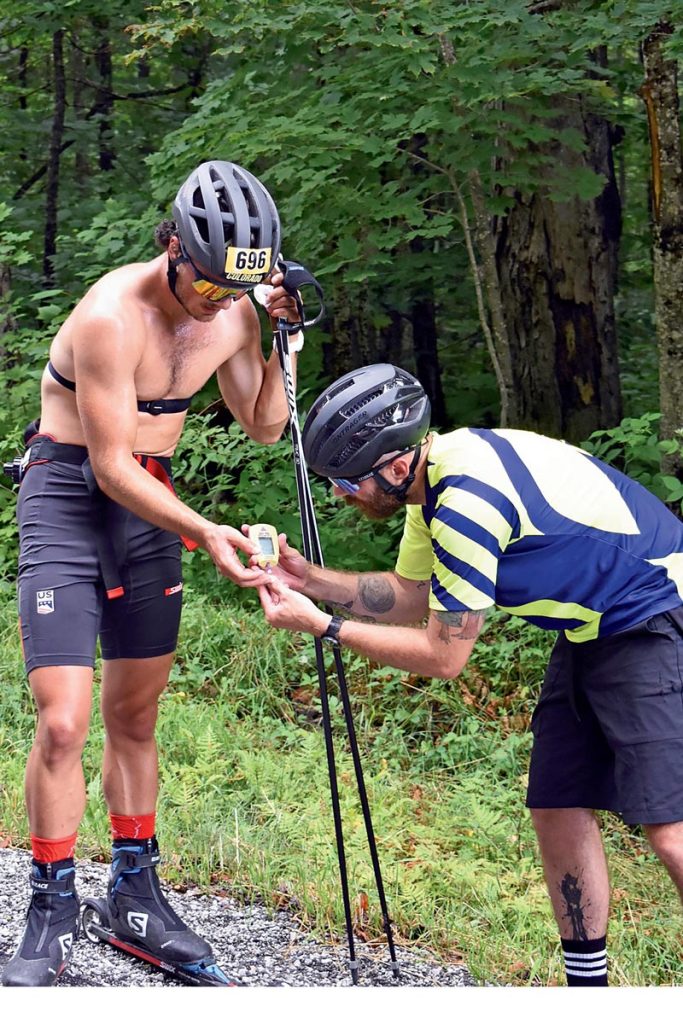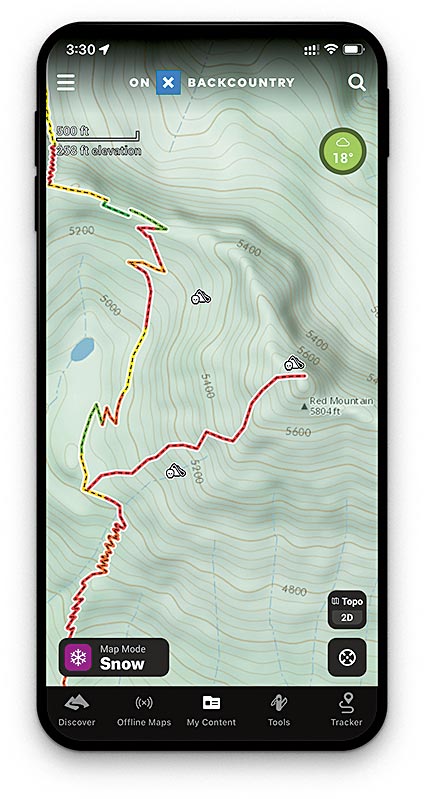
“If it’s not on Strava, it didn’t happen,” reads the T-shirt of a skier in our Nordic club. The shirt was given to him by a teammate during the height of a Strava overload last season, when numbers and maps from the popular training app were the subject of discussion on every run, roller ski and bike ride. Each morning session began with talk about what workouts skiers from other clubs had accomplished the day prior, and every hill thereafter became an opportunity to get a top leaderboard slot. A workout was suddenly a means to an end, and the joy in being outside and striving for improvement was seemingly overshadowed by data, graphs and egos.
As the coach, it didn’t take long for me to take action. I put together several days of “Strava-free” training, bringing out a plastic cooler to collect everyone’s watches, phones and heart-rate monitors prior to a run in the woods. Wouldn’t you know it? The run still happened, even without any digital proof.
Don’t get me wrong, technology plays an important role in training and performance. In fact, we humans have been using science and technology to improve our athletic pursuits at least since the first pair of skis was carved and shaped from wood. Today’s tools can serve as a modern way to carve and shape a training plan or interval workout into a data masterpiece. Here are a few tech tools and apps that I’ve used in coaching and training that can be valuable, as long as you use them in moderation or don’t become too caught up in the details.
Strava: The “Towing Hill” segment
When used consciously, Strava can actually be a fun and dynamic training tool. Case in point: Our ski club often rollerskis on a local road with a short, gradual hill. Because it’s in a relatively empty neighborhood, we’re able to do repeats on the hill for strength, power and speed. We call it the Towing Hill because sometimes we use stretchy cords to tow one another up it for extra resistance.
There’s usually some lighthearted trash-talking about the various times in which pairs ascend the Towing Hill, with lots of debate on whose GPS watch most accurately records the data. It’s easy for skiers to motivate for repeats in even the worst weather when the Towing Hill leaderboard is on the line. Yet nobody takes it seriously enough for the situation to get toxic.
Heart-rate monitors: Still relevant
Let’s get this out of the way first: I don’t trust wrist-based, infrared heart-rate monitors. While this technology appears to make life simple, chest-strap versions are still the gold standard for accurate, real-time measurements and data displays. When placed on the chest and close to the heart itself, the electrode sensors on a strap can instantly relay pulse information to your wrist.
Today’s tools can serve as a modern way to carve and shape a training plan or interval workout into a data masterpiece.
Why does it matter? The heartbeat is a key indicator of exertion and keeping an eye on your heart rate can help ensure that you’re getting the correct training benefit, whether you’re on a relaxed, long-distance run or tackling a set of tough uphill skate intervals. One common method of determining your maximum heart rate is to subtract your age from 220—admittedly, not the most scientific method. Wear a heart-rate monitor as often as you can during workouts to correlate your heart rate with perceived exertion. By tracking yourself during the hardest workouts and races, particularly during uphill events in the 12- to 18-minute range, you can (and should) get you pretty darn close to your heart’s maximum exertion.
Lactate testing: Going the extra step
If gleaning information from your heartbeat alone can tell you a lot about your training effort, how much is a drop of blood worth? Lactate testing uses a small, expensive (about $350) machine to analyze blood for the concentration of lactic acid, or lactate, in it. The test itself is carried out much like a blood sugar test—skin is pricked on a finger or earlobe to extract a drop of blood. The blood sample is then read by test strips on the lactate testing device to determine the millimoles per liter of lactic acid.
What does that have to do with exercise? Things can get complicated quickly, but what follows is a very basic and somewhat scientific explanation of how adenosine triphosphate (ATP) and lactic acid affect the body during exercise. (For more detailed information, I highly recommend the book Training for the Uphill Athlete, by Steve House, Scott Johnston and Kilian Jornet.) ATP is the molecule used to power muscle contractions, and when your metabolism breaks down fat and sugars into ATP, your body receives the energy needed to function, down to the cellular level. Even autonomic systems like breathing and digestion require ATP, which is why we need fuel just to survive, let alone exercise.
Your metabolism produces ATP in two ways, depending on the type of energy you expend. During high-intensity exercise, your body creates ATP via anaerobic glycolysis, which is a fast but volatile path to obtain energy. During low-intensity exercise, the body uses oxygen alongside fats and sugars to produce a much higher output of ATP, but at a slower rate.
Lactic acid is a byproduct of increased anaerobic glycolysis, meaning the millimoles of lactate in the blood can key us into how hard the body is pushing and what energy systems it uses to produce ATP. The much-heralded lactate threshold is the point at which the body begins to accumulate more lactate than it can clear effectively. We then must slow down, whether we want to or not.
Lactate testing allows you to pinpoint what’s happening on a cellular level in the body and train more effectively.
With a lactate testing kit, athletes and coaches in the field can periodically take tabs on their lactate production to ensure they stay below their threshold (typically under 2.0 mmols/liter, but even this number can vary) during a workout that’s intended to be low intensity. They can also run tests on a treadmill or stationary bike, gradually increasing intensity and taking regular blood samples to correlate lactate production with heart rate. When used with a heart-rate monitor, lactate testing allows you to pinpoint what’s happening on a cellular level in the body and train more effectively.
Interested in further exploring lactate testing without plunking down for a machine? Local collegiate or club teams, especially for endurance sports such as skiing or running, often have lactate testing equipment. These teams may even offer a testing facility or “human performance lab” with options for local athletes to sign up for a session. Or contact any professional coaching resources and centers in your area, which are often affiliated with cycling; they may be able to point you in the right direction to access, and interpret, lactate testing.
Online mapping tools: Always know where you are
A training outing can quickly devolve into an exercise in frustration if you get lost. Apps like Gaia, Trailforks and OnX use your smartphone location and GPS to pinpoint your bearings, with overlays that include trails, named peaks and topographic lines. If you’ve ever looked at a paper map and wished for a “you are here” arrow, these programs deliver.

While maps are great for planning purposes, these digital tools can be invaluable in stressful situations where you really lose track of where you’re at. This has happened to our team a few times, and apps saved the day, in instances ranging from sweaty summer hikes to frigid backcountry skis. Ironically, our perilous hiking and skiing situations occurred on some of our most familiar mountains, which goes to show how seriously a trip into the woods should be taken, no matter your experience level.
YouTube: Use it for motivation, not memes
Though it may seem otherwise, YouTube is not just a home for meme videos and livestreams. Our ski club uses the platform in various ways, from watching motivational and funny vlogs that recap a training camp to repeatedly viewing a five-second clip of an athlete skiing up a hill to examine their technique. And YouTube provides a vast library of resources. Until recently, it used to be a chore to dig up videos of cross country ski races, but now you can watch and replay the most obscure ski event in the tiniest of Scandinavian towns.
The videos also reflect how far filming technology has come, from being able to record HD footage on smartphones to uploading ski clips wirelessly before a workout is even finished. Granted, we live in a world in which seeing and sharing ourselves online can happen dangerously easily, putting privacy and personal comfort at risk. But with careful forethought as to the process and content being handled, athletes and coaches can connect with the ski world like never before.
Now you can watch and replay the most obscure ski event in the tiniest of Scandinavian towns.
A final note: With screen time burning through our retinas, and new apps continually coming online to overcome even the smallest inconveniences, it’s important to remember that skiing is a sport best enjoyed with the cold, snowy world right in front of us. Yes, technology has helped us find ways to connect with skiing, and with other skiers, beyond gliding through the woods. But this vast array of tools is best used to enhance our experiences outside rather than complicate them. As you explore the ways in which your phone or computer, as well as other devices, can aid your skiing, be sure to take time outside of the digital world and immerse yourself in the real landscape.
This story first appeared in the Autumn 2022 issue of Cross Country Skier (42.1).
